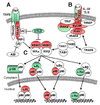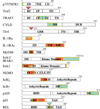Alternative splicing in the NF-kappaB signaling pathway
- PMID: 18718859
- PMCID: PMC2624576
- DOI: 10.1016/j.gene.2008.07.015
Alternative splicing in the NF-kappaB signaling pathway
Abstract
Activation of transcription factor NF-kappaB can affect the expression of several hundred genes, many of which are involved in inflammation and immunity. The proper NF-kappaB transcriptional response is primarily regulated by post-translational modification of NF-kappaB signaling constituents. Herein, we review the accumulating evidence suggesting that alternative splicing of NF-kappaB signaling components is another means of controlling NF-kappaB signaling. Several alternative splicing events in both the tumor necrosis factor and Toll/interleukin-1 NF-kappaB signaling pathways can inhibit the NF-kappaB response, whereas others enhance NF-kappaB signaling. Alternative splicing of mRNAs encoding some NF-kappaB signaling components can be induced by prolonged exposure to an NF-kappaB-activating signal, such as lipopolysaccharide, suggesting a mechanism for negative feedback to dampen excessive NF-kappaB signaling. Moreover, some NF-kappaB alternative splicing events appear to be specific for certain diseases, and could serve as therapeutic targets or biomarkers.
Figures


References
-
- Arend WP. The balance between IL-1 and IL-1Ra in disease. Cytokine Growth Factor Rev. 2002;13:323–340. - PubMed
-
- Beg AA, Baltimore D. An essential role for NF-κB in preventing TNF-α-induced cell death. Science. 1996;274:782–784. - PubMed
-
- Beg AA, Sha WC, Bronson RT, Ghosh S, Baltimore D. Embryonic lethality and liver degeneration in mice lacking the RelA component of NF-κB. Nature. 1995;376:167–170. - PubMed
-
- Bignell GR, et al. Identification of the familial cylindromatosis tumour-suppressor gene. Nat. Genet. 2000;25:160–165. - PubMed
Publication types
MeSH terms
Substances
Grants and funding
LinkOut - more resources
Full Text Sources

